5 of Australia's Most Annoying Insects

Bites and Stings

As we head towards the summer months, insects will increasingly venture inside to escape the heat. Though it's never nice to run into an insect in the home, there are a handful of insects that are particularly annoying.
The warmer seasons are fast approaching. And with that, Australians are gearing up for some outdoor summer fun. However, some insects do not enjoy the heat and prefer to retreat indoors. Others, like the Funnel-web spider, prefer to cool down by lounging and floating in the local residents’ backyard pools. Unfortunately, there are plenty of insects to go around, and you'll likely run into some while hiking or traversing the Great Outdoors. As most Australians know, running into insects is rarely a pleasant experience, especially when they pay no heed to your personal space, and you have to constantly swat them away from your face or otherwise suffer their wrath. On that note, let’s take a look at 5 of Australia’s most annoying insects.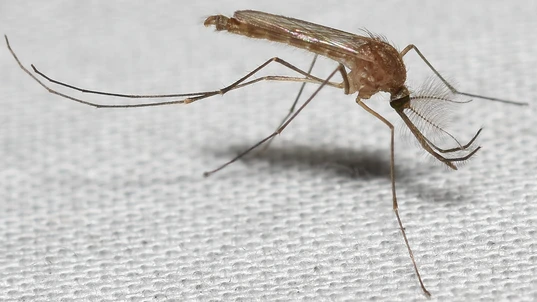
Mosquitoes are flying insects that are common throughout Australia. Female mosquitoes feed on human blood. When they bite a human, female mosquitoes can leave itchy red swells and transmit diseases.
Mosquitoes
There are over 300 different species of mosquitoes found in Australia, common flying insects that are mostly grey in colour with white stripes across their abdomen. All mosquitoes have two wings, a “humpback” and distinctive long legs. You can find them near clean water within the domestic environment, artificial containers such as water ponds or at freshwater bodies.Annoying attributes
- Itchy bites: Only female mosquitoes bite people and animals to secure a blood meal in order to nourish their developing eggs. The common reaction to a mosquito bite are itchy red swells.
- Transmit diseases: As well as being nuisances, mosquitoes can transmit serious human diseases. They are often infected with various viruses and parasites, which they can then transmit to any person or animal they bite. It only takes a few infected mosquitoes to start an outbreak in a community. In Queensland, there are types of mosquitoes that can transmit dengue, chikungunya and zika viruses.
How to avoid running into them?
- Wear loose clothing with long sleeves and pants.
- Apply mosquito repellent on all exposed skin areas.
- Avoid the outdoors or take preventive actions during peak mosquito biting hours to reduce risk of infection.
- Stop adult mosquitoes entering your home by using fly screens on windows and doors.
What to do if a mosquito bites you?
- Wash the area with soap and water.
- Apply an antiseptic.
- Use a cold pack to ease the swelling and the pain.
- If you develop a rash, fever or chills, see your doctor immediately.
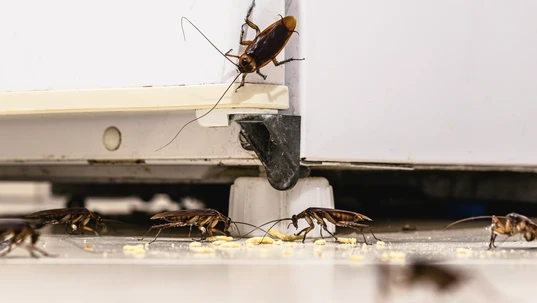
Cockroaches can be found on every continent except Antarctica, as they are genetically predisposed to survive in most conditions. They are also incredibly fast and can fly, which means they can spread disease easily.
Cockroaches
Cockroaches have been around for more than 300 million years in every continent except Antarctica. They are adaptable creatures that can survive in most environmental conditions. They have a flat body that helps them wiggle into tiny spaces and an armoured shell for protection. They spend most of their lives seeking shelter and scavenging for food. Thus, they are found commonly indoors where food and water are readily available.Annoying attributes
- Unpredictable movements and super speed: They are one of the fastest terrestrial creatures on Earth. Their speed evolved as an escape mechanism from predators.
- Their slick look: Their cuticle secretes a lipid-based wax to prevent water loss.
- Transmit harmful bacteria: Like salmonella and E.coli. These bacteria swim through cockroaches' waxy outer layers and can survive for up to two months.
- Trigger allergy: They produce allergens that can worsen asthma and trigger allergic reactions in people.
- The ability to fly: They use their wings to glide from higher levels to lower surfaces when they want to get away quickly from a threat.
How to avoid running into them?
- Seal cracks and holes.
- Throw away any cardboard boxes.
- Clean your kitchen thoroughly and regularly.
- Do not leave food out in the open.
- Restrict easy access to water sources.
What to do if a cockroach bites you?
- Wash the bite area with water and soap to reduce risk of infection.
- Apply a cold pack to reduce swelling.
- Apply an antihistamine topical cream if the bite area gets too itchy.
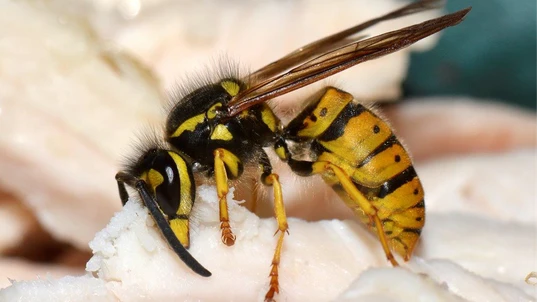
Though native to areas in the northern hemisphere, European wasps were introduced to Australasia in the 1940s. They can be aggressive when disturbed and, unlike bees, they can sting several times without dying.
Wasps
There are more than 100,000 species of wasp in the world. Wasps are related to bees and ants, and they have a bright yellow abdomen with black bands. They also have two pairs of clear wings, the first of which is larger, and they typically build their larges nests underground or in ceilings, logs and trees.Annoying Attributes
- Aggressive: Wasps are more aggressive than bees and will launch an attack if they feel their nest is threatened.
- Stingers: Unlike bees, they do not die after stinging and so can sting more than once.
- Dangerous to humans: Their sting can trigger an allergic reaction (anaphylaxis) in some people.
How to avoid running into them?
- Dispose all food scraps around the yard, as they are attracted to food and sugary drinks.
- Do not leave uneaten pet food outside.
- Ensure your rubbish bins have tight fitting lids.
- Make sure your compost is covered at all times.
- Cover exposed food at picnics and barbeques.
- Check opened food and drink containers before you eat or drink from them.
What to do if a wasp stings you?
- Wasps rarely leave their stinger in the skin.
- Wash the affected area with soap and water.
- Apply a cold pack to relieve pain and reduce swelling.
- Take a pain reliever to reduce continued pain.
- If the affected area deteriorates, the pain worsens or you begin experiencing allergy symptoms, seek medical attention.
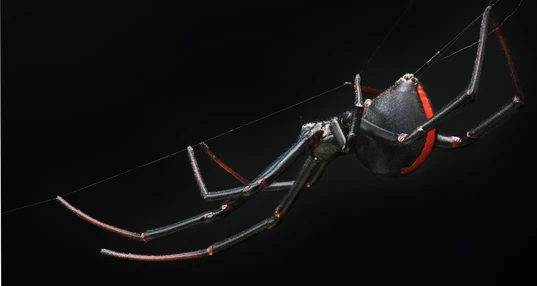
Redback spiders are widely distributed across Australia and like to hang out in urban dwellings. Redback spider bites can be incredibly painful and cause serious symptoms like abdominal pain and shallow breathing.
Spiders
Spiders have been on the planet for millions of years, working as Mother Nature's controllers of insect populations. A spider typically has a head and a thorax, eight legs, eight eyes, fangs and abdominal organs that spin silk. Different species of spiders are found in different locations, for example:- Redback spiders are less common in colder regions and are generally found in backyards.
- White tail spiders are generally found beneath rocks, bark, and leaf litter.
- Funnel-web spiders are generally found on the ground where they build burrows in cool, sheltered areas, though some species choose to dwell in trees.
Annoying attributes
- Spider rain: There have been reports by Australians of “millions of spiders falling from the sky”. Experts call this phenomenon 'ballooning', a method that some spiders use to get around.
- Big cities, big spiders: A study conducted in 2014 found that certain types of spiders tend to grow bigger in urban spaces and highly populated areas with hard, concrete surfaces and little vegetation.
- Venomous: Almost all species of spiders are venomous, though not all spider venom is poisonous to humans, as it is typically used to poison prey. In saying that, there are an estimated 25 types of spiders that have venom that is potent enough to harm humans.
- Swimmers: There are some spider species that live almost completely underwater. As such, you can not always expect to escape a spider by diving into a freshwater lake. There might be spiders lurking beneath.
- Resistant to pesticides: Spiders tend to repopulate in areas from which they have been previously eliminated.
How to avoid running into them?
- Shake out your shoes and clothes before you wear them if they have been left outside for a while.
- Avoid leaving clothes or towels on the floor.
- Wear shoes when you are outside.
- If you ever see a spider in a swimming pool, never assume that it has drowned. Most spiders will survive off the air bubbles attached to their legs for hours. The deadly Funnel-web spiders are great swimmers and are known to cool down in backyard swimming pools during hot days. Before jumping in, inspect the pool for spiders. If you do see one, fish it out with a pool net.
What to do if a spider bites you?
Funnel-web spider bite
- Keep the casualty at rest, reassured, and under observation.
- Call 000 or 112.
- Follow the basic life support guidelines per DRSABCD.
- Apply the Pressure Immobilisation Technique. The purpose of the pressure immobilisation technique is to prevent the venom from moving into circulation, thereby "buying" the patient time while they wait for medical treatment. Wrap a bandage over the bite site as tightly as you would a sprained ankle. Extend the bandage all the way up the limb, and then immobilise the limb. Note, the pressure immobilisation technique should only be used for Funnel-web spider bites and snake bites.
- Do not use a tourniquet.
- Do not cut, suck, or wash the bite site.
Redback spider bite
- Reassure the casualty and keep them under constant observation.
- Apply a cold compress to the bite site for periods of up to 20 minutes to lessen the pain.
- If the casualty is a young child (under 8 years), a pregnant woman, or if they exhibit any signs of deterioration, call Triple Zero (000) for an ambulance.
- DO NOT use the Pressure Immobilisation Technique, as the venom moves slowly and this will just worsen the pain.
Most other spider bites
Any bite from a large (i.e. greater than 2 cm) dark coloured spider in parts of NSW or South East Queensland should be treated as a possible bite from a Funnel-web spider. Any bite from a large (i.e. smaller than 2 cm) spider or a light-coloured spider should be treated as a possible bite from a Redback Spider. For more information on how to identify and treat bites from some of Australia's deadliest spiders, head to our Resource Library.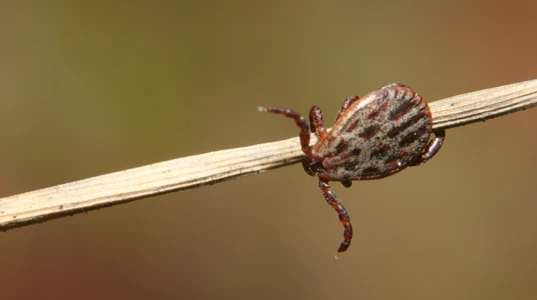
Ticks are parasites that feed on human and animal blood. They attach themselves to their hosts in hard-to-see areas using a hooked mouth part. They can be difficult to spot and remove, and can spread fatal diseases.
Ticks
Ticks are parasites that feed on human and animal blood. There are about 70 different types of ticks in Australia. Some ticks have a flat body and a long mouth while others are wrinkled and leathery in texture. They are most commonly found along the east coast.Annoying attributes
- Disease: Ticks feed on various hosts, and so can receive and transmit several different bacteria, viruses, and parasites. In humans, ticks commonly cause Lyme disease, a bacterial infection signalled by fever, fatigue, and sore muscles and joints. If left untreated, Lyme disease can spread through the bloodstream and cause inflammation of the brain and heart.
- Persistent: Ticks grip onto their hosts with their mouth parts. These mouth parts contain hooks that act as mini harpoons - they pry the skin open and then anchor the tick to the skin until they gorge themselves on blood and fall off. As such, they can be difficult to remove in one foul swoop. The head often remains stuck to the skin and continue to transmit pathogens.
- Sneaky: Though ticks can attach themselves to any part of the human body, they tend to preference areas with soft skin and plenty of blood supply, such as the groin and underarms. As such, they can be difficult to identify and remove quickly, and it only takes 36 to 48 hours for the Lyme disease bacterium to be transmitted.
- When you are going to places where there might be ticks, wear long sleeves and tuck your trousers into your socks. Try to cover as much of your skin as possible.
- Use an insect repellent that contains diethyltoluamide (DEET) to repel ticks.
- Brush your clothes and inspect your skin for ticks as soon as you get home.
- Put your clothes in the hot dryer for at least 20 minutes to kill any ticks.
- Follow DRSABCD and be prepared to perform CPR.
- If the casualty displays signs of anaphylaxis, follow the Australian Resuscitation Council's Anaphylaxis Guideline.
- Immediately kill the tick where it is using an ether-containing spray (for suitable products, refer to your pharmacist).
- Wait for the tick to drop off.
- If the casualty has a history of tick allergy, seek medical attention from a doctor to remove the dead tick.
- Move the casualty to a safe place.
- Apply a cold compress to help reduce pain and swelling.
- Monitor the casualty at all times. Be alert for signs of allergic reaction.
- Provide reassurance.
How to avoid running into them?
What to do if a tick bites you?
Due to the risk of anaphylaxis, removal of ticks by force is no longer recommended by the Australian Resuscitation Council. The below steps are recommended, instead:Final thoughts
To learn how to identify, prevent and manage different bites and stings, check out the articles below and book a First Aid course with us today:
Originally published at
https://www.australiawidefirstaid.com.au/resources/australias-most-annoying-insects
as part of the Australia Wide First Aid Articles Library









